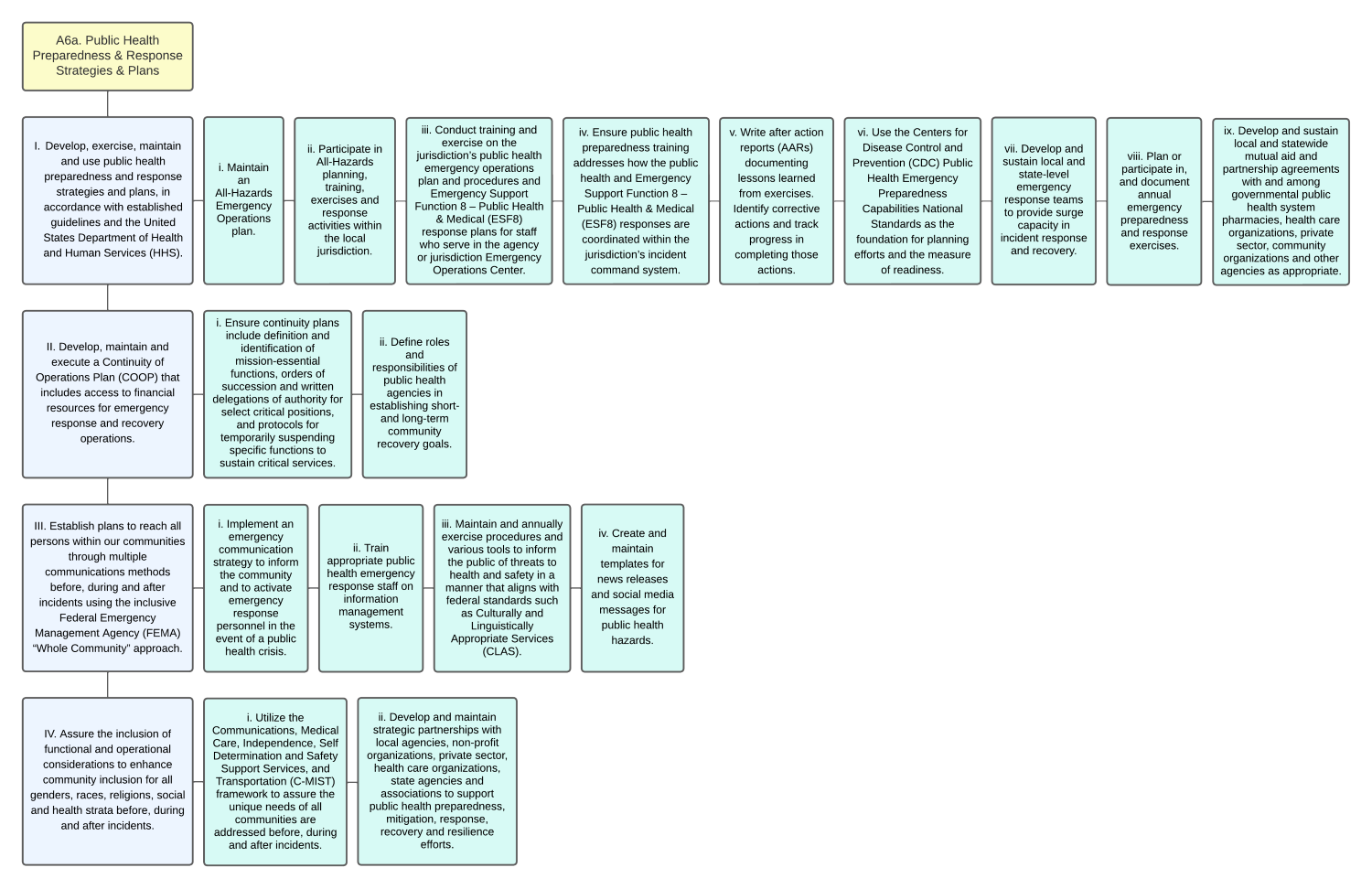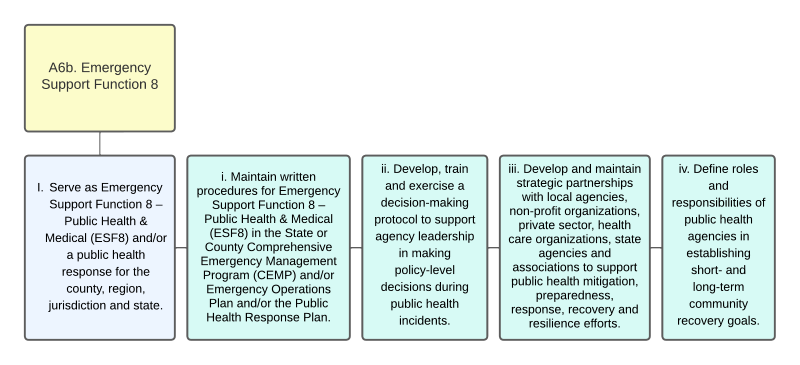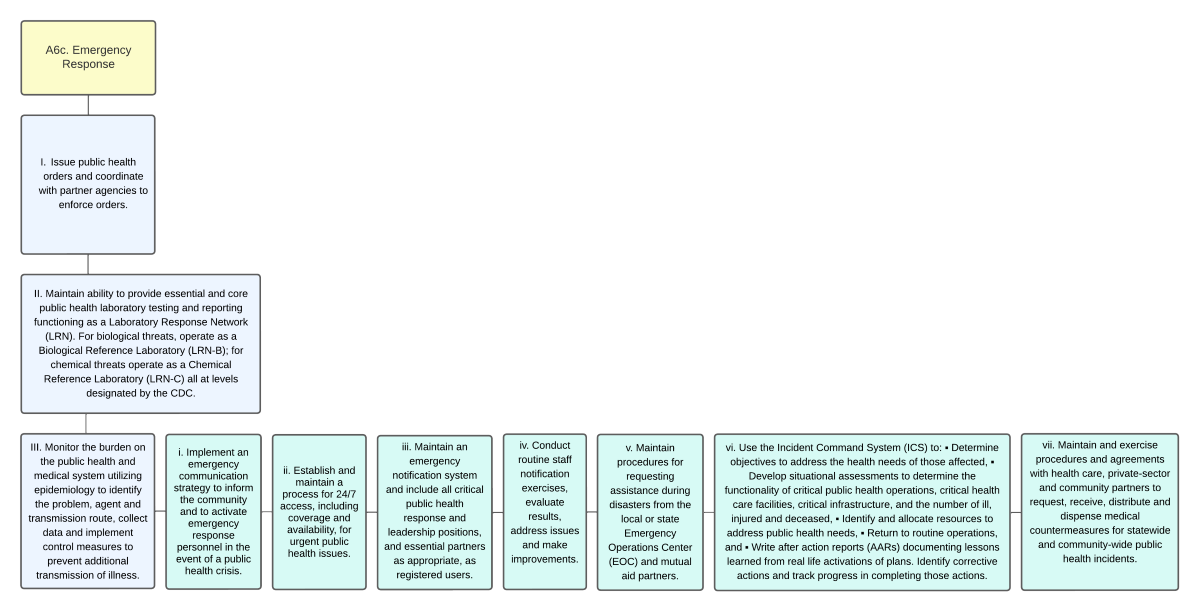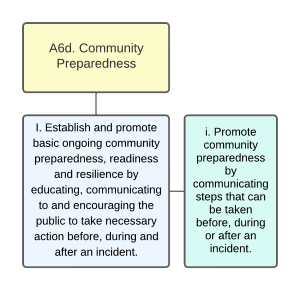A6. Emergency Preparedness and Response
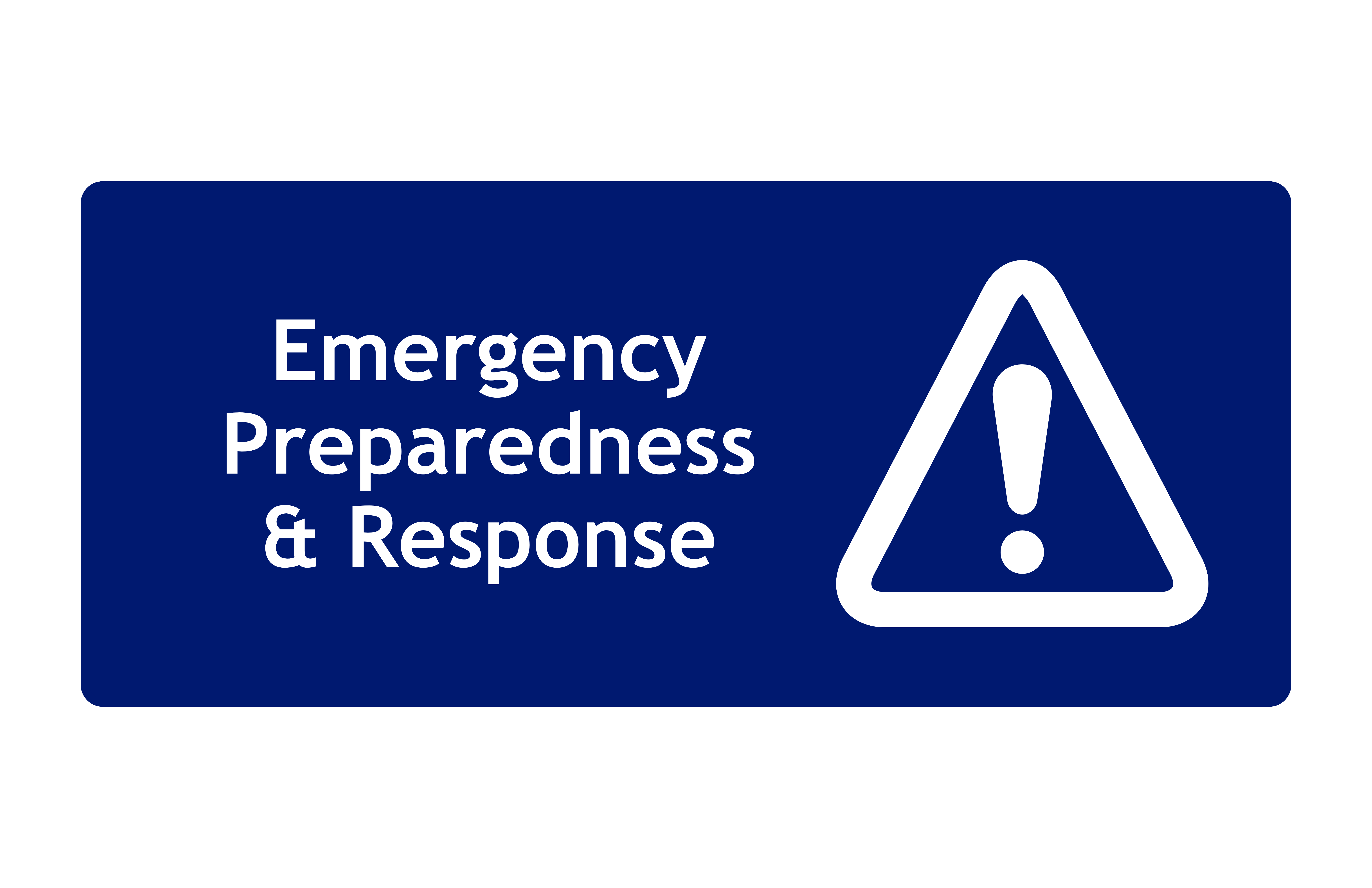
Emergency Preparedness and Response: Colorado’s governmental public health system, in coordination with federal, state and local agencies and public and private sector partners, will have the capability and capacity to prepare for, respond to, and recover from emergencies with health, environmental and medical impacts.
Links:
The source Core Public Health Services Operational Definitions Manual 2019 is organized as follows:
|
Functions of Emergency Preparedness and Response
A6a. Public Health Preparedness and Response Strategies and Plans
I. Develop, exercise, maintain and use public health preparedness and response strategies and plans, in accordance with established guidelines and the United States Department of Health and Human Services (HHS).
i. Maintain an All-Hazards Emergency Operations plan.
ii. Participate in All-Hazards planning, training, exercises and response activities within the local jurisdiction.
iii. Conduct training and exercise on the jurisdiction’s public health emergency operations plan and procedures and Emergency Support Function 8 – Public Health & Medical (ESF8) response plans for staff who serve in the agency or jurisdiction Emergency Operations Center.
iv. Ensure public health preparedness training addresses how the public health and Emergency Support Function 8 – Public Health & Medical (ESF8) responses are coordinated within the jurisdiction’s incident command system.
v. Write after action reports (AARs) documenting lessons learned from exercises. Identify corrective actions and track progress in completing those actions.
vi. Use the Centers for Disease Control and Prevention (CDC) Public Health Emergency Preparedness Capabilities National Standards as the foundation for planning efforts and the measure of readiness.
vii. Develop and sustain local and state-level emergency response teams to provide surge capacity in incident response and recovery.
viii. Plan or participate in, and document annual emergency preparedness and response exercises.
ix. Develop and sustain local and statewide mutual aid and partnership agreements with and among governmental public health system pharmacies, health care organizations, private sector, community organizations and other agencies as appropriate.
II. Develop, maintain and execute a Continuity of Operations Plan (COOP) that includes access to financial resources for emergency response and recovery operations.
i. Ensure continuity plans include definition and identification of mission-essential functions, orders of succession and written delegations of authority for select critical positions, and protocols for temporarily suspending specific functions to sustain critical services.
ii. Define roles and responsibilities of public health agencies in establishing short- and long-term community recovery goals.
III. Establish plans to reach all persons within our communities through multiple communications methods before, during and after incidents using the inclusive Federal Emergency Management Agency (FEMA) “Whole Community” approach.
i. Implement an emergency communication strategy to inform the community and to activate emergency response personnel in the event of a public health crisis.
ii. Train appropriate public health emergency response staff on information management systems.
iii. Maintain and annually exercise procedures and various tools to inform the public of threats to health and safety in a manner that aligns with federal standards such as Culturally and Linguistically Appropriate Services (CLAS).
iv. Create and maintain templates for news releases and social media messages for public health hazards.
IV. Assure the inclusion of functional and operational considerations to enhance community inclusion for all genders, races, religions, social and health strata before, during and after incidents.
i. Utilize the Communications, Medical Care, Independence, Self Determination and Safety Support Services, and Transportation (C-MIST) framework to assure the unique needs of all communities are addressed before, during and after incidents.
ii. Develop and maintain strategic partnerships with local agencies, non-profit organizations, private sector, health care organizations, state agencies and associations to support public health preparedness, mitigation, response, recovery and resilience efforts.
A6b. Emergency Support Function 8
I. Serve as Emergency Support Function 8 – Public Health & Medical (ESF8) and/or a public health response for the county, region, jurisdiction and state.
i. Maintain written procedures for Emergency Support Function 8 – Public Health & Medical (ESF8) in the State or County Comprehensive Emergency Management Program (CEMP) and/or Emergency Operations Plan and/or the Public Health Response Plan.
ii. Develop, train and exercise a decision-making protocol to support agency leadership in making policy-level decisions during public health incidents.
iii. Develop and maintain strategic partnerships with local agencies, non-profit organizations, private sector, health care organizations, state agencies and associations to support public health mitigation, preparedness, response, recovery and resilience efforts.
iv. Define roles and responsibilities of public health agencies in establishing short- and long-term community recovery goals.
A6c. Emergency Response
I. Issue public health orders and coordinate with partner agencies to enforce orders.
II. Maintain ability to provide essential and core public health laboratory testing and reporting functioning as a Laboratory Response Network (LRN). For biological threats, operate as a Biological Reference Laboratory (LRN-B); for chemical threats operate as a Chemical Reference Laboratory (LRN-C) all at levels designated by the CDC.
III. Monitor the burden on the public health and medical system utilizing epidemiology to identify the problem, agent and transmission route, collect data and implement control measures to prevent additional transmission of illness.
i. Implement an emergency communication strategy to inform the community and to activate emergency response personnel in the event of a public health crisis.
ii. Establish and maintain a process for 24/7 access, including coverage and availability, for urgent public health issues.
iii. Maintain an emergency notification system and include all critical public health response and leadership positions, and essential partners as appropriate, as registered users.
iv. Conduct routine staff notification exercises, evaluate results, address issues and make improvements.
v. Maintain procedures for requesting assistance during disasters from the local or state Emergency Operations Center (EOC) and mutual aid partners.
vi. Use the Incident Command System (ICS) to:
- Determine objectives to address the health needs of those affected,
- Develop situational assessments to determine the functionality of critical public health operations, critical health care facilities, critical infrastructure, and the number of ill, injured and deceased,
- Identify and allocate resources to address public health needs,
- Return to routine operations, and
- Write after action reports (AARs) documenting lessons learned from real life activations of plans. Identify corrective actions and track progress in completing those actions.
vii. Maintain and exercise procedures and agreements with health care, private-sector and community partners to request, receive, distribute and dispense medical countermeasures for statewide and community-wide public health incidents.
A6d. Community Preparedness
I. Establish and promote basic ongoing community preparedness, readiness and resilience by educating, communicating to and encouraging the public to take necessary action before, during and after an incident.
i. Promote community preparedness by communicating steps that can be taken before, during or after an incident.
